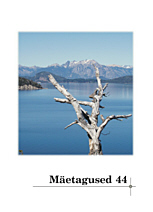Rahvaesteetika – nähtavaks kujustatud mõte ja kogemus
Folk Aesthetics – Ideas and Experience Made Tangible
Author(s): Kärt SummatavetSubject(s): Fine Arts / Performing Arts
Published by: Eesti Kirjandusmuuseum
Keywords: Ants Laikmaa; Estonian National Museum; folk aesthetics; folk art; folklore; fieldwork: heritage technologies; Kristjan Raud; professional art
Summary/Abstract: The article raises a question as to how to implement the imagination of a researcher in the study of tangible cultural heritage, using the example of Kristjan Raud and Ants Laikmaa, artists who worked at the beginning of the 20th century, and their art theory related and pedagogical standpoints. The observation focuses on how the texts, written by these artists a hundred years ago, attempt to understand folk aesthetics, folk art practice, oral and tangible folklore, and identify these with the experience of creative process of professional art. The article highlights the viewpoints and opinions which affected the creative work of K. Raud, and were used by the artist to learn and study the mindset of the authors of tangible heritage. A closer look is taken at the specific problems encountered by the artist upon the interpretation of cultural heritage. Folk aesthetics comprises individual fantasy and creativity, expressed by way of oral and visual poetry, which is based on the creative process taking place as an outcome of the synthesis of the hierarchical stratifications of shared experience within the surrounding environment and the community. When attempting to treat folk aesthetics in the light of the professional knowledge and skills of an artist, we can investigate the creative process launched by individual fantasy and creativity, expressed by way of oral and visual poetry; as an outcome of such creative process, new ideas and artefacts with idiosyncratic details may be generated within the traditional community, upon the individual interpretation of shared knowledge and experience. An artist, when looking for reciprocal relations between heritage technologies, oral folklore and human creative fantasy, would not come across an artefact but instead, the mindset of the author thereof, and the nuances concerning the process of making the artefact. The hardest task of a creative professional is to learn to see the worldview and the empirical experience of the creator of the artefact, individual fantasies expressed by way of the process of creation, and collectively shared ethical and aesthetical values. Indeed, from an artist’s and practitioner’s viewpoint, this remains to be one of the most problematic aspects in the study of contemporary creative work, as it is extremely difficult to research experiential knowledge and tacit knowledge of tradition bearers. The study of the variability of the relationships, regarding individual creative experience and Estonian tangible heritage, reveals an opportunity to understand the relevance of empirical fieldwork and experiential knowledge of an art professional, by way of the written works and opinions expressed by Kristjan Raud, a thinker and awakener at the beginning of the 20th century, in noticing and interpreting these relationships.
Journal: Mäetagused. Hüperajakiri
- Issue Year: 2010
- Issue No: 44
- Page Range: 7-28
- Page Count: 22
- Language: Estonian

